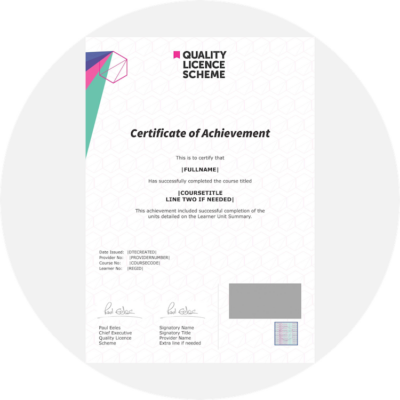
Awarding body:
Skills and Education Group
Study time:
12 months
Study method:
Online
£299.00
Our Primatology Level 3 course is perfect for anyone seeking to understand about different primates and how to identify these animals. Look at the differences between apes, monkeys and prosimians as well as how each has evolved to the modern day.

Choose your enrolment options
About this Primatology Level 3 Course
Studying our Primatology Level 3 course allows you to fully understand the different primates and their habitats. Locations of differing primates around the world are covered as well as diet, identification, taxonomy, evolution and mating habits. The Primatology Level 3 is perfect for people already working with animals as well as anyone else that has a keen interest in primates.
| Study Time: | 100 hours |
| Enrolment length: | 12 months |
| Course Format: | Online |
| Entry Requirements: | None Specific |
Upon completion of this course students receive a Quality Licence Scheme certificate and an OLC Certificate. All certification fees are included in your course fees.
Primatology Level 3 Certification
To complete this Primatology Level 3 course you will need to submit, and pass, all of the tutor marked assignments. There are six assignments in the course and no need to purchase any textbooks as we provide all of the lessons and materials required to learn the syllabus. All assignments are coursework based and are in an essay/question and answer style to test your knowledge of the topics covered in each of the course sections.
Course Content
This course assesses the following units:
Unit 1: Primates
Chimpanzees and bonobos are our closest living relatives. In fact, we are so alike, we share over 98% of the same DNA. As crucial as that final 2% difference must be there is no denying our close bond and evolutionary history. In this course, we explore the family of animals we belong to, the primates. We start here by exploring how the primates fit into the broader animal kingdom, and we explore ways to name, describe and compare different species.
Unit 2: Platyrrhini (The New World Monkeys)
The New World monkeys are defined, not just by where in the world they live but also by the shape of their face and their nostrils. The name of this group, Platyrrhini, is derived from a combination of Latin and Greek that means “flat-nosed” and it is this facial feature that makes them externally, visually different from their Old World relatives. So, what does this actually mean? Well, the New World monkeys don’t have a prominent external nose, but instead, two sideways facing nostrils with a wide septum separating the two.
In this unit, we look at some of the main families of New World monkeys and explore their global distribution and some of the challenges they face.
Unit 3: Catarrhini (the Old World monkeys)
This unit will look at the old world monkeys and consider the different species, their habitats, characteristics and eating habits.
We will consider how close to extinction some of these monkeys are due to the threat of deforestation and loss of habitats and consider their breeding habits and behaviour.
Unit 4: The Great Apes
Of all the primates on the planet, perhaps our closest affinity is with those referred to as the great apes. Notice, they are referred to as apes rather than monkeys, they all lack a tail, they have complex social structures and interactions and are some of the most intelligent animals on the planet – of course, humans are among their number. They are also all found mostly in Africa while the orangutans are native to Asia, and so are old world primates with the familiar haplorrhine nose.
Unit 5: The Lesser Apes
Around 17 million years ago, the great apes diverged into another group of species. Some 12 million years after the old world monkeys had diverged, this new group, the lesser apes, emerged. Once represented by a single genus the lesser apes, or gibbons, are now classified into four genera, comprising a total of 20 different species. In this unit we will explore the four genera and identify the members of these groups, contrasting their global distribution and their varying behaviours and characteristics. We will see that, even though they are smaller than their hominid relatives, they’re not necessarily that much less intelligent. Their lives and social structures are still complex and additionally some of their species have developed fascinating adaptations that make them perfectly suited to their arboreal lifestyle.
Unit 6: The Lemurs of Madagascar & the prosimians
The final group to look at on our whistle-stop tour of the world of primates, is the prosimians. These animals are primates just like the apes and monkeys, but they have certain characteristics that are considered more primitive than their more complex simian relatives. They are thought to have evolved from the common primate ancestor earlier than any other group and have therefore retained some of these simpler, more archaic traits as a result. In this unit we explore the two main groups of prosimian primates, and we look closely at the island of Madagascar, home to many of the world’s prosimians and consider why almost all its wildlife is completely endemic to the island.
Online study and instant enrolment
All of our students are given access to our Online Campus through their own personal login and password. As soon as you complete your enrolment, you would have immediate access to your account which allows you to make a start working through the lessons. Tackle your assignments as your own pace and contact your tutor to access any help and support you need. The course itself is set out in a very simple layout, making it easy to work through the topics and complete your assessments.
Our Online Campus includes:
- Instant enrolment – access everything on your course from the moment you enrol.
- Personal account logins – login any time, 24/7.
- Full support throughout – message your tutor, use our online chat or give us a call.
- Online assignment submissions – upload work online from the comfort of home.
- Self-led learning – study at your own pace so you can pass much faster.
- Safe e-portfolio system – store all of your work in your account.
- Progression tracking – easily see what assignments you have left to complete.
- Details help centre – get instructions and guidance every step of the way.
- Unlimited attempts – submit as many attempts at your assignments as you need.
Unlimited assessment submissions
All of the assessments for this course are completed through our Online Campus. You can attempt each one as many times as needed to ensure you pass. After every attempt, your tutor will provide detailed feedback and tips on how you can improve going forward. Quickly see your progress during your studies by checking your progress bar and seeing the remaining assessments you need to complete.
Get full tutor support
Throughout your enrolment with the Online Learning College, you can access support at any time you need. All students are assigned a personal tutor who will mark all of your work and provide detailed feedback after every submission. Your tutor will be an industry expert with a full knowledge of the course content and will be able to help you at any point along your learning journey. One of the best tools at your disposal is your tutor – you can ask as many questions of them as you wish to and they will be happy to help at any time.
We also have a brilliant support team on hand and available through email, online chat and over the phone. This team is there to help with any questions which are more generic, such as providing support in submitting work through your account or getting your certificate when you have completed your course. We pride ourselves on ensuring the support you receive is the best in the business – help and guidance is fast and detailed every time you contact a member of the team.
Assessments
To pass this course learners must pass 6 assignments. These are completed after navigating through the corresponding lessons and writing your answers to assignment questions. Once these have been read and marked by your personal tutor, feedback and marks are provided to students which contain helpful tips to improve work in future assignments.
Enrolment Length
All of our courses are allocated plenty of time for students to complete their studies and all materials are self-led so that you can complete the course at your own pace, but you have access to the course on the Campus for 12 months from your enrollment date. Should you require additional time on one of our courses you can extend your enrolment by 30 days for an additional fee of £60. As well as this we operate a 14 day money back guarantee on every one of our qualifications- that’s how confident we are of how you will love studying with us!

Quality License Scheme Certification
At the end of this course, successful learners will be given the option to receive a Certificate of Achievement from the Quality Licence Scheme and a Learner Unit Summary (which lists the components the learner has completed as part of the course).
Quality License Scheme Certificate
All Certification Costs Included
Frequently Asked Questions
Learn more about this course and others that we offer. If you still have any questions, simply contact our course advisors on 0800 772 0887 or email info@ol-college.com.
What is included in this Primatology Level 3 course?
All of our courses come with everything you need. Your lessons, tuition and certification costs with the Quality Licence Scheme are included in the cost of this course. There is nothing else that you need to buy or pay for in order to finish the course and get your certificate.
Is this course regulated?
At the end of this course successful learners will be given the option to receive a Certificate of Achievement from the Quality Licence Scheme and a Learner Unit Summary (which lists the components the learner has completed as part of the course).
The course has been endorsed under the Quality Licence Scheme. This means that Oakwood Home Learning has undergone an external quality check to ensure that the organisation and the courses it offers, meet defined quality criteria. The completion of this course alone does not lead to a regulated qualification* but may be used as evidence of knowledge and skills gained. The Learner Unit Summary may be used as evidence towards Recognition of Prior Learning if you wish to progress your studies in this subject. To this end the learning outcomes of the course have been benchmarked at the level shown against level descriptors published by Ofqual, to indicate the depth of study and level of demand/complexity involved in successful completion by the learner.
The course itself has been designed by Oakwood Home Learning to meet specific learners’ and/or employers’ requirements which cannot be satisfied through current regulated qualifications. The Quality Licence Scheme endorsement involves robust and rigorous quality audits by external auditors to ensure quality is continually met. A review of courses is carried out as part of the endorsement process.
The Quality Licence Scheme is part of the Skills and Education Group, a charitable organisation that unites education and skills-orientated organisations that share similar values and objectives. With more than 100 years of collective experience, the Skills and Education Group’s strategic partnerships create opportunities to inform, influence and represent the wider education and skills sector.
The Skills and Education Group also includes two nationally recognised awarding organisations; Skills and Education Group Awards and Skills and Education Group Access. Through our awarding organisations we have developed a reputation for providing high-quality qualifications and assessments for the education and skills sector. We are committed to helping employers, organisations and learners cultivate the relevant skills for learning, skills for employment, and skills for life.
Our knowledge and experience of working within the awarding sector enables us to work with training providers, through the Quality Licence Scheme, to help them develop high-quality courses and/or training programmes for the non-regulated market.
*Regulated qualification refers to those qualifications that are regulated by Ofqual / CCEA / Qualification Wales
Do I have to sit an exam?
No, there are no exams for this Primatology Level 3 course. Everything is assessed through coursework and assignments which you can submit at anytime within the enrolment term.
Am I assigned a tutor for this Primatology Level 3 course?
You are! Once you have enrolled then you will have an assigned tutor, this person is the one who will be marking your work, providing feedback, and passing your work. If you need to speak to your tutor at any time throughout your enrollment then you can message them via the campus and they will reply within 24 hours of out working hours.
Can I speak to someone before I enrol?
Of course! We have course advisors and a customer service team in the office Monday to Friday 9am until 5pm who will be happy to help and answer any questions that you may have. You can call us on 0800 772 0887, email us at info@ol-college.com or we even have a live chat facility.
How long do I have to study?
The enrolment term is 12 months, however, as long as you complete all of the written assignments and practical tasks (if applicable) then you can complete the course sooner if you wish. If you need any additional time after the 12 months then you can also extend which costs £60 per month and you can do this as many times as needed.
What are the payment options?
There are various payment options for this Primatology Level 3 course. The first option will be for you to purchase the course and pay in full upon enrolment. The second option is the pay monthly option, this is completely interest free and splits the cost into 12 monthly payments. Finally, we can send an invoice with 30 days payment terms if your employer will be funding the cost of the course – if you would like this option, then please ask your employer to get in contact with us so we can provide them with the details we will need.
Do you offer any funding for the course?
Unfortunately we don’t offer any free or funded courses but you can split the cost into 12 monthly payments which is completely interest free.
Do I need to buy anything else for this Primatology Level 3 course?
Everything that you will need will be provided to you when you enrol, you will also need to complete some of your own research too. Buying text books and other resources can become costly so we don’t ask you to or recommend buying anything, there is lots of free and very useful information online!
How do I see my course material/resources?
Everything that you will need for your course will be accessible on our online campus. You can select the online and paper versions of most of our courses too, if you select this option then there will be an additional £35 cost, this covers the cost of us printing out a full course pack in a ring binder folder and sending out via Royal Mail 1st Class, Tracked & Signed delivery.
How do I log in and access my course?
Once you have enrolled then you have access to the campus right away to get started on your course. You can log in by going to our website and clicking ‘Log in’ at the top right hand side of the page. Your username is the email address that you used to enrol and your password is the one you created at the checkout when enrolling.
When will I receive my certificate?
Once you have completed and passed all units and your course is paid in full (either paid in full upon enrolment or if paying monthly then the remaining balance paid or monthly payments complete), then we can request your certificate from the Awarding Body. Certificate’s take 6-12 weeks to arrive with us and once we receive it we will then contact you to confirm the address to post it to. Certificate’s are sent via Royal Mail 1st Class, Tracked & Signed delivery.
What happens if I fail an assignment?
If you fail an assignment, then please do not worry! You can resubmit your assignment as many times as needed until you pass. Each time you submit an assignment then your tutor will mark it and provide feedback, you can then make the amendments and resubmit and have the new version marked again.
How long does it take to mark my work?
We have a marking timescale of 5 working days from the submission, your tutor will mark your work and provide feedback with if you need to make any amendments to enable you to pass. Please note, we do ask that learners don’t upload more than one submission at a time as this will delay the marking not just for yourself but for other learners too.
Do I have to attend or view any live/virtual lessons?
You don’t, everything is in written, text, image and diagram format. You will have access to the campus 24/7 to be able to log in and complete your work. You won’t need to view any videos or audio lessons.
What device can I/shall I use?
As you will have assignments to write and type up for submission then we would recommend using a computer or laptop for this as you will need to use a software such as Microsoft Word or Google Docs to type these. You may also be able to use an iPad/tablet for this. You can use a smartphone if you wish but you may find it difficult and it would probably be easier on a larger screen/device.
How do I complete my assignments?
Once you have enrolled and accessed the campus you will see your assignment tasks and criteria of what needs to be covered in each assignment.
Our latest reviews
Fully supported by an online tutor
Our courses come with full tuition from an expert tutor. Your tutor can be contacted through our messaging system, and the same person will provide feedback on your assignments. We also have a dedicated admin team on hand to help over the phone, through live chat, and by email.
1 working day for replies to messages
5 working days for feedback on assignment
Our turnaround times are the best in the industry!

Start today with immediate enrolment
Expert support at all times
Our speedy support promise
When you study with us, we ensure a speedy service. That's why our current timeframes for marking and support are the best in the business.





